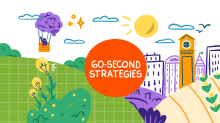Illustration: Katie Lukes
Strategies for K-2 Primary School Social & Emotional Learning (SEL)
Explicitly teaching and celebrating kindness is a simple yet powerful way to build a positive classroom culture.
Collaborative Learning
When kids explain their mathematical thinking to their peers, they learn there’s more to math than just the right answer.
Social & Emotional Learning (SEL)
Nurture a positive, supportive atmosphere in your classroom with fun and fast peer shout-outs.
Classroom Management
When students help each other in the classroom, they gain confidence and independence—and you get to keep on teaching.
Social & Emotional Learning (SEL)
A simple activity can help preschoolers better understand boundaries and learn to be gentle when it comes to physical contact.
Formative Assessment
This quick exercise scaffolds peer critique for elementary students.
Classroom Management
Looking for an easy way to ensure all voices are heard in your classroom? Try equity sticks.
Social & Emotional Learning (SEL)
A short contemplative exercise can help students calm themselves and get ready to learn.
Teaching Strategies
When teachers make their teaching and learning goals clear to their class, every activity has a purpose and every student understands what they’re doing.
Strategies for 3-5 Upper Elementary Communication Skills
This fun classroom activity helps students find their voice by teaching the basics of debate in an accessible way.
Teaching Strategies
By making small goal setting part of the everyday routine, teachers help students build the skills they need to achieve larger and longer-term objectives.
Social & Emotional Learning (SEL)
An opening and closing exercise where every student contributes is a way to ensure that they all feel seen and heard in the classroom.
Assessment
This simple activity helps students practice giving and receiving peer feedback—and gets them out of their desks.
Teaching Strategies
When students need to get their wiggles out so they can settle down to learn, this fun movement-based brain break does the trick.
Student Voice
A quick formative assessment tool also encourages all students—even shy ones—to participate in discussions.
MATH
Demystify math word problems with this easy technique that helps kids see the story beyond the numbers.
Communication Skills
Improve the quality of class discussions by giving young kids a checklist of key things to look for when their peers talk.
Teaching Strategies
When students take charge of their own feedback, they learn to work with others in the room—and not just their friends.
Strategies for 6-8 Middle School Communication Skills
A simple strategy encourages students to give their full attention when listening to others.
Collaborative Learning
Giving students randomly assigned roles in their group work helps ensure that they all participate.
Classroom Management
An easy, fair way to manage multiple students' needs when they’re working independently or in groups.
Literacy
Looking for a way to get your students writing—fast? Try a low-stakes timed exercise.
Assessment
A face-to-face chat provides an alternative for students who struggle to show what they know on tests.
Classroom Management
An intentional greeting at the door forges a strong teacher-student bond.
Assessment
A quick way to get students talking positively about their peers’ work—and thinking about how they might improve their own.
Student Engagement
This simple technique can help ease students’ anxiety about sharing out in class—and make it more fun.
Communication Skills
Providing the active listeners in the outer ring of a Socratic circle a way to jump in with their burning questions and comments keeps all students engaged.
Collaborative Learning
Getting students up on their feet and solving problems together helps build engagement—and stronger math thinkers.
Formative Assessment
With a series of quick check-ins, students can assess their own learning—which lets teachers plan their next lesson with ease.
Strategies for 9-12 High School Teaching Strategies
Getting content to stick can actually be fun if you use a quick and energetic activity to review the material.
Communication Skills
A discussion technique based on peer feedback helps students delve into complex texts and develop communication skills.
Blended Learning
A basic pen-and-paper warm-up activity helps teachers see that students are on track in a self-paced blended learning classroom.
Communication Skills
With a simple discussion activity that gets every learner in the class speaking and listening, teachers can help students boost conversation skills—and develop their opinions.
Classroom Management
A quick, low-key way to build community in your classroom on a daily basis.
Communication Skills
Following discussions with a short reflection exercise helps students sharpen their speaking and listening skills.
Mental Health
An active, fun classroom activity fosters open dialogue while releasing pent-up energy.
Classroom Management
For anyone who’s ever wondered, “How do I get their attention back in a 1:1 environment?”
Formative Assessment
A strategy for using a quick, whole-class reflection on content as a verbal exit ticket.
Professional Learning
Having staff stand for meetings keeps them tight—15 minutes, max—and efficient.
Collaborative Learning
The team competition is fierce in this informal assessment activity, in which students have to work together to win.
Literacy
By giving each student a job to do when tackling complex text, teachers help ensure that students actually understand what they are reading.
